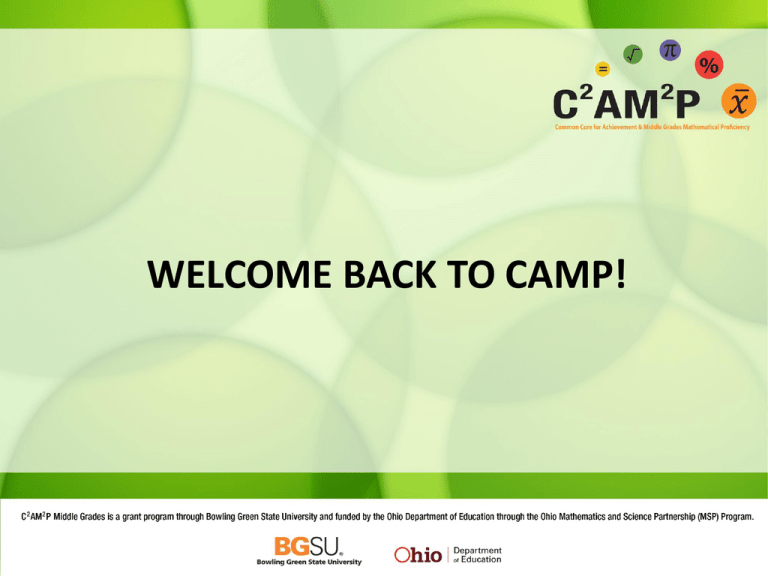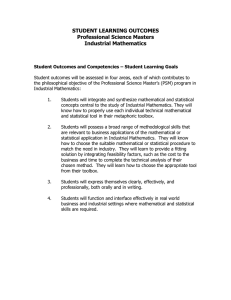Session 5 REV C Jan 16 2015
advertisement

WELCOME BACK TO CAMP! What’s golden? Agenda • Warm-Up for statistical and probabilistic thinking • Norms for our PD • Recapping from lesson study • Discussing OCTM • NCTM (2007) Teaching Standards: Learning environment • Break • Statistics Task • Lunch • Exploring Statistics and Probability Content Standards • Standards for Mathematical Practice • Synthesizing from the Day • Student evaluation • Closure Request for help Students enrolled in EDTL 2740 need to conduct 2-4 hours in a grades 7-8 learning environment as well as 2-4 hours in a high school environment. If you’re willing to let students come into your classroom then please let Dr. Bostic know. I’m looking for your help. You can put them to work doing whatever you need them to do, as long as it helps them better understand the life of a teacher. Warm-up Activity in Stats and Prob What do frogs eat? Evolving Norms for this PD • We will be ready for class and use our class time effectively. • We will keep our focus on learning and use technology for personal reasons during breaks. • We will be respectful of each other’s time and space and work efficiently. • We will actively participate by (a) listening to each other, (b) giving others our attention, (c) not speaking when someone else is talking, and (d) regularly sharing our ideas in class. • If we disagree with someone or are unclear, we will ask a question about his or her idea and describe why we disagree or are confused. • We will ask questions when we do not understand something. We will comment on others’ ideas rather than the person. Evolving Norms for this PD O We will take advantage of opportunities to share ideas and gather feedback through presentations. O We will encourage one another to share ideas. O We will show our appreciation to one another after a presentation by applause. O If we disagree with someone or are unclear about their ideas related to mathematics content and pedagogy, we will ask a question about his or her idea and describe why we disagree or are confused. O We will ask questions when we do not understand something about mathematics content and pedagogy. O We will comment on others’ ideas about mathematics content and pedagogy rather than the person. Evolving Norms for this PD • We will always look for another approach to solve problems. • We will use pictures, graphs, tables, symbols, numbers, manipulatives, and/or words to assist us while doing mathematics. • We will persist with every problem and examine it from multiple perspectives. • We will be mathematically precise whenever possible. • We will explain and justify our ideas in a way that everyone can understand. Preparing for Lesson Study on 2/6 • • • • New Group members Grade 6 Lima North Grades 7 and 8 Lima West Lesson study sequencing – Start planning lesson in groups today. – Continue planning lesson at Jan 23 session. Meet with Christy or Dr. Bostic to discuss plan. – Finish lesson planning by Jan 31 (Saturday) and upload to website. Ohio Council of Teachers of Math Conference NCTM Standards for Teaching and Learning as Related to the Common Core State Standards (2007) 1. Knowledge of Mathematics and General Pedagogy 2. Knowledge of Student Mathematical Learning 3. Worthwhile Mathematical Tasks 4. Learning Environment 5. Discourse 6. Reflection on Student Learning 7. Reflection on Teaching Practice Frayer models: Learning Environment Break SMP 1. Make sense of problems and persevere in solving them 2. Reason abstractly and quantitatively. 3. Construct viable arguments and critique the reasoning for using them. CCSS 7.SP.5 Understand that the probability of a chance event is a number between 0 and 1 that expresses the likelihood of the event occurring. Larger numbers indicate greater likelihood. A probability near 0 indicates an unlikely event, a probability around ½ indicates an event that is neither unlikely nor likely, and a probability near 1 indicates a likely event. 7.SP.7b Develop a probability model (which may not be uniform) by observing frequencies in data generated from a chance process 7.SP.8 Find probabilities of compounding events using organized lsts, tables, tree diagrams, and simulation What kinds of things do frogs eat? What might their diet depend upon? Habitat Bags Bag 1: Marsh Bag 2: Stream Bag 3: Tropical Garden ========================================== Each bag containing colored cubes: blue – flies, green – worms, yellow – snails Statistical Question of the Day: What statistical question might we ask based on the information we’ve been given? “Is the probability of choosing blue, green, yellow cubes different from bag to bag?” or “Does habitat have any influence on a frog’s food choice?” COLLECT APPROPRIATE DATA Step 1: Trial Number 1 Results Trial Number 11 2 12 3 13 4 14 5 15 6 16 7 17 8 18 9 19 10 20 Results Categorical Association What graphical representations could we make to display our numerical analyses? ANALYZE THE DATA Step 2: Color Blue Green Yellow Total Frequency Relative Frequency ANALYZE DATA Step 3: Questions about your habitats: • What is the most likely food choice from each habitat? • What is the experimental probability of selecting the most likely food choice from each habitat? • What is the experimental probability of selecting a fly from each habitat? • What is the experimental probability of selecting a worm from each habitat? • What is the experimental probability of selecting a snail from each habitat? How can we gain better estimates? Answer to our question: Is the probability of choosing blue, green, yellow cubes different from bag to bag? Thinking through a Lesson Read the article by Smith, Bill, and Hughes (2008). After reading, jot notes for yourself about the following questions: • What will I attend to in Part 1 of the TTLP? That is, what do I perceive as key elements? • What will I attend to in Part 2 TTLP? That is, what do I perceive as key elements? • What will I attend to in Part 3 of the TTLP? That is, what do I perceive as key elements? • Your lesson study group will agree on a subset of questions for each Part and explicitly address them in your lesson. Thinking through a Lesson • Here’s the questions/prompts we used from the TTLP. • Selecting and Setting Up a Mathematical Task – What errors might students make? – How will students record and report their work? • Supporting the Students’ Exploration of the Task – What assistance will you give or what questions will you ask a student (or group) who become quickly frustrated and requests more direction and guidance in solving the task? – What will you do if a student (or group) finishes the task almost immediately? How will you extend the task so as to provide additional challenge? • Sharing and Discussing the Task – What solution paths do you want to have shared during the class discussion? In what order will the solutions be presented? Why? – What specific questions will you ask so that students will expand on, debate, and question the solutions being shared? LUNCH MATH TEACHER OBSERVATIONS DICE, PROBABILITY, AND CANDY Standards for Mathematical Practice: With commentary for grades 6-8 • Standard for Mathematical Practice 1: Make sense of problems and persevere in solving them • Standard for Mathematical Practice 2: Reason abstractly and quantitatively • Standard for Mathematical Practice 3: Construct viable arguments and critique the reasoning of others Lesson Study Lesson study is a professional development process to systematically examine one’s instructional practice, with the goal of becoming more effective. This examination centers on teachers working collaboratively on a small number of "study lessons". Working on these study lessons involves planning, teaching, observing, and critiquing the lessons. To provide focus and direction to this work, teachers select an overarching goal and related research question that they want to explore. This research question then serves to guide their work on all the study lessons. While working on a study lesson, teachers jointly draw up a detailed plan for the lesson, which one of the teachers uses to teach the lesson in a real classroom (as other group members observe the lesson). The group then comes together to discuss their observations of the lesson. Often, the group revises the lesson, and another teacher implements it in a second classroom, while group members again look on. The group will come together again to discuss the observed instruction. Finally, the teachers produce a report of what their study lessons have taught them, particularly with respect to their research question. Lesson Study: Action Plan • Overarching goal: • To collaborate in ways that help us improve our mathematics teaching and learning and reflect upon those actions. • Immediate goals: • Each group will design, enact, reflect upon, and improve one mathematics lesson per semester. This lesson will be taught twice during one day by the same instructor. • This is a learning process for everyone: the instructional team, you, and your lesson study group. Be patient, flexible, and open to trying something new. Lesson Study: Action Plan • Expectations: • Lessons should provide outlets for co-teaching and offer rich learning opportunities for ALL learners. • The focal task should be a problem, not an exercise that is immediately solved with a previously learned strategy. The problem ought to be complex, open, and have realistic elements. The goal is to promote problem solving, not efficiency with a known procedure. You have approximately 45 minutes for your lesson. • Ideas for promoting mathematical student-teacher and studentstudent discourse should be evident in the lesson. Questions prompting mathematical discussions, including eliciting misconceptions, must be present. • The lesson should not be teacher-focused. Lesson Study: Action Plan 1. In your lesson study group, discuss the TTLP. Your group members should agree on 2-3 questions from each part that you will address in this lesson. 2. Begin to frame your lesson using the “tool for planning…” and keep the research question in mind: “How does this lesson support students’ content learning through engagement in the mathematical practices? “ Note: Your final lesson must be uploaded to the website by 11:59pm on Saturday, January 31. You will receive feedback that week. Synthesizing from the Day 1. What evidence from today’s PD that was indicative of an effective learning environment? What are the next steps for your group’s lesson? In other words, what needs to be done by Friday? Take Care • Next meeting is Friday January 23 @ Lima HS. • Please ask any questions to Dr. Stats and/or Dr. Math. • Most importantly, keep in touch!



